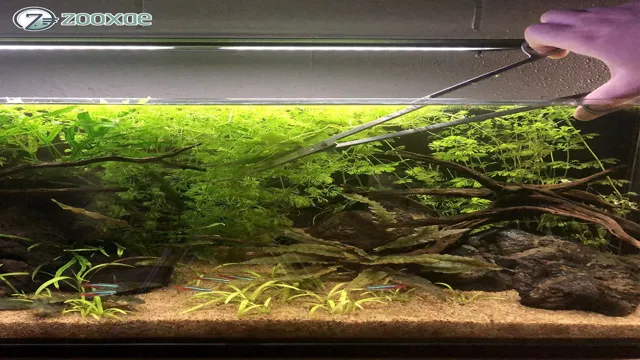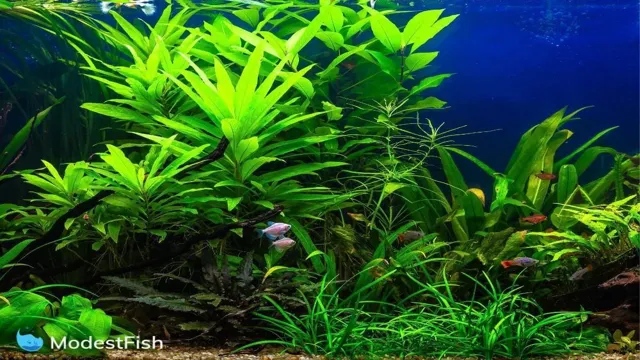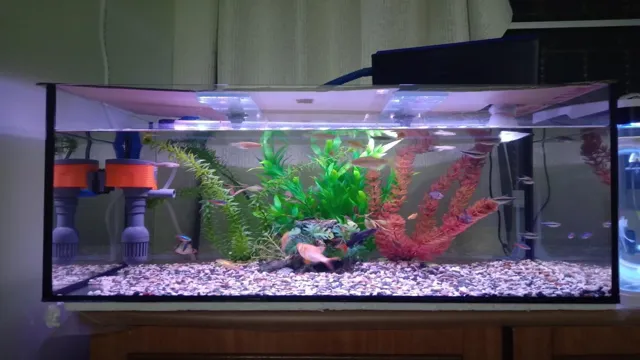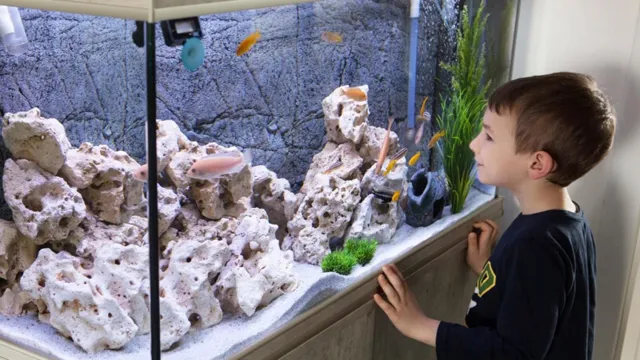How to Hide Aquarium Filter Intake with These Simple Tips and Tricks
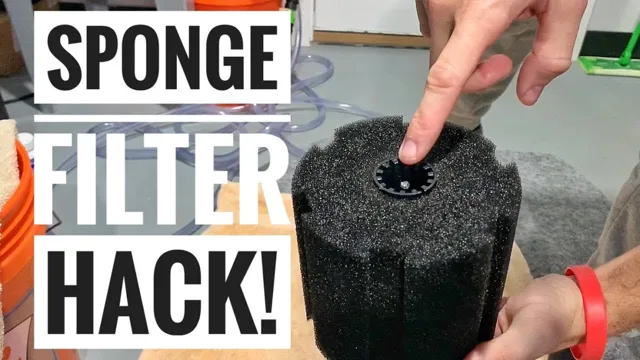
If you’re the proud owner of an aquarium, you know how important it is to keep the water clean and filtered. However, those unsightly filter intakes can be a bit of an eyesore, ruining the aesthetic appeal of your aquarium. Luckily, there are several ways to hide your aquarium filter intake, without sacrificing the effectiveness of your filter or harming your fish.
In this blog post, we’ll go over some creative and easy solutions to conceal your aquarium filter intake, giving you a sleek and clean-looking aquarium that you’ll love.
Introduction
If you’re looking for ways to hide your aquarium filter intake, you’re not alone. Many aquarium owners find the large, unsightly filter intake detracts from the aesthetic of their tank. The good news is there are several easy ways to hide your filter intake and improve the appearance of your aquarium.
One simple option is to use decorative rocks or live plants to cover the intake. Another option is to install a pre-filter sponge, which not only hides the intake, but also provides additional filtration for your aquarium. Additionally, you can position your filter intake behind decorations or ornaments in your tank.
By implementing one or more of these strategies, you can give your aquarium a clean, polished look while still ensuring your filter is functioning properly.
Why hide your aquarium filter intake?
If you are an aquarium enthusiast, you must be aware of the importance of keeping the water clean and clear. However, what most people overlook is the role of the aquarium filter intake in maintaining the water’s quality. It may seem like a minor detail, but hiding your aquarium filter intake can have a significant impact on your aquatic pets’ health.
By concealing the intake, you can prevent your fish from getting sucked in, injured, or even killed. Additionally, debris and other particles can build up around the intake, restricting the flow and hindering the filter’s effectiveness. Therefore, hiding the intake not only safeguards the fish but also improves the overall cleanliness of the tank.
So, let’s delve into why hiding your aquarium filter intake is crucial and how you can do it efficiently. Keyword: aquarium filter intake.

Tools and Materials Needed
When it comes to hiding an aquarium filter intake, there are a few tools and materials you’ll need to get the job done. First and foremost, you’ll need some type of decorative cover to conceal the intake. This could be a synthetic plant, some rocks or stones, or even a piece of driftwood.
Make sure that whatever you choose is sturdy and won’t be moved around by the flow of water from the filter. You’ll also need some aquarium-safe adhesive to secure the cover in place. Aquarium silicone or hot glue should do the trick.
Additionally, you may want to consider purchasing a pre-made intake cover or modifying a sponge filter to serve as a cover. With a little creativity and some careful placement, you can easily hide your aquarium filter intake and give your tank a more natural and aesthetically pleasing look.
Mesh or sponge material
When it comes to crafting, choosing the right tools and materials can make all the difference in the outcome of your project. If you’re working with a mesh or sponge material, you’ll want to make sure you have the right tools on hand. For mesh materials, you’ll need a pair of scissors, a rotary cutter, and a cutting mat.
This will help you to cut your material cleanly and smoothly, without any fraying or jagged edges. Additionally, you may want to have a ruler on hand to ensure straight lines. When working with sponge materials, it’s important to have a sharp utility knife or scissors that are capable of cutting through the material without tearing it.
You’ll also want to have a ruler or straight edge to guide your cuts. With the right tools on hand, you’ll be able to create high-quality projects that will impress anyone who sees them. So go ahead, get creative, and have fun with your mesh or sponge materials!
Scissors or knife
Scissors or knife – when it comes to crafting and DIY projects, having the right tools can make all the difference. Whether you need to cut fabric, cardboard, or other materials, the choice between scissors and a knife can depend on the intricacy of the job. Scissors are ideal for cutting shapes and curves, making them useful for sewing, paper crafts, and more.
They also come in a variety of styles, such as pinking shears for preventing fraying and embroidery scissors for delicate cuts. On the other hand, a knife can be more versatile for cutting thicker or denser materials like leather or cardboard. A utility knife with a retractable blade can also be convenient for various cutting needs.
It’s important to choose the tool that’s the best fit for your specific project to ensure a successful outcome. So, whether you prefer the precision of scissors or the strength of a knife, it’s always important to have the right tool for the job.
Zip ties or rubber bands
When it comes to organizing cables and wiring in your workspace or home, you’ll need some tools and materials to get the job done right. Zip ties and rubber bands are two common solutions, but which is best for the job? Zip ties are great for securing cables in place and preventing them from getting tangled or caught on objects. They are made of strong nylon material with a locking mechanism that keeps them firmly in place.
On the other hand, rubber bands are more flexible and easier to remove compared to zip ties, making them ideal for temporarily bundling cables together. However, they are not as durable as zip ties and may break or lose their elasticity over time. In general, if you need a long-term solution, zip ties are the way to go.
But if you just need a quick fix, rubber bands can work in a pinch. Keep both on hand for different situations and always choose the right tool for the job at hand.
Aquarium safe glue (optional)
If you’re planning to set up a new aquarium at home, you’d need some specific tools and materials to get started. Firstly, you’ll require an aquarium tank, which is available in various sizes and shapes. Choose one that fits your space and aesthetic preferences.
Next, you’ll require a filtration system to keep the water clean and healthy for your fish. There are different types of filtration systems available such as internal, external, or canister filters, and you can select one based on the size of your tank and the number of fish. Apart from that, you’ll need a heater to regulate the water temperature and an aquarium-safe thermometer to monitor the water temperature in real-time.
Also, a substrate layer is required to cover the bottom of the tank, and you can choose from gravel, sand, or rocks. Finally, for decoration, you can use natural or artificial plants, driftwood, or corals. If you want to keep the decorations in place, you can use aquarium safe glue, which is optional, but it’s essential to select a glue that won’t harm your fish or damage the tank in the long run.
By having these tools and materials, you can create a safe, healthy, and thriving ecosystem for your aquatic pets in no time.
Methods to Hide Aquarium Filter Intake
Are you tired of looking at your aquarium filter intake pipe cluttering up the aesthetic of your beautiful aquarium? Fortunately, there are many methods to effectively hide the intake and make your aquarium look clean and appealing. One approach is to use live plants to camouflage the filter pipe. Simply choose plants that are tall enough to effectively hide the intake and are compatible with your fish and aquarium environment.
Another popular option is to use aquarium decorations like rocks, driftwood, or artificially designed ornaments to cover the intake. Some people even choose to paint the intake to match the color of the substrate or aquarium background, making it blend in seamlessly. Whatever method you choose, make sure to regularly clean the intake to maintain proper water flow and keep your aquarium healthy and thriving.
1. Cover with a sponge material
If you’re worried about the unsightly view of your aquarium filter intake, don’t worry, covering it with a sponge material is one of the simplest and most effective ways to keep it hidden. Sponge filters are a popular choice for aquarium enthusiasts for filtering water and concealing the intake as well. The sponge covers the intake to prevent any fish from getting sucked in and also provides an additional surface for useful bacteria to grow and help break down waste.
Using a sponge material will give your aquarium a clean finish and also improve water quality. It’s important to note that the sponge should be cleaned regularly so that it doesn’t get clogged and continue to function efficiently. Overall, covering your aquarium filter intake with a sponge material is a great way to hide this functional equipment while keeping your aquatic friends safe and improving water conditions.
2. Cover with a mesh material
When it comes to aquarium filter intakes, one effective way to hide them is by covering them with a mesh material. This not only hides the unsightly plastic tubing but also prevents fish, shrimp, and other aquarium inhabitants from getting sucked into the filter. A mesh material can be purchased online or at a pet store, but make sure that it is fine enough to prevent any small creatures from slipping through.
Simply cut the mesh to size and attach it securely to the filter intake with aquarium-safe silicone and zip ties. You can even choose a mesh color that matches your aquarium decor to blend in even more seamlessly. This method not only hides the filter intake but also adds an extra layer of safety for your aquatic pets.
So why not give it a try and see the difference it can make in the appearance of your aquarium setup?
3. Use decorative objects to hide the intake
Aquarium filter intake can be an eyesore in an otherwise beautiful tank. Luckily, there are ways to hide it using decorative objects. One method is to use aquarium plants to disguise the intake.
Choose a plant that has long, flowing leaves that can drape over or around the intake. Another option is to use rocks or driftwood to cover the intake. This not only hides the filter, but also adds a natural aesthetic to the tank.
Finally, you could use ornaments such as statues or caves to obscure the intake. These objects can be chosen to fit the theme of your tank. Whatever method you choose, be sure to regularly clean and maintain the intake to ensure proper filtration.
With a little creativity, you’ll hardly notice the filter intake in your aquarium.
Maintenance of the Hidden Aquarium Filter Intake
Keeping your aquarium clean is essential for the health of your fish, and that includes making sure your filter intake stays gunk-free. However, having a visible intake can detract from the aesthetics of your tank. So, how can you hide your aquarium filter intake while still retaining its functionality? One option is to place it behind a rock or a decorative piece of driftwood.
However, you’ll still need to ensure that your filter can access sufficient oxygenated water for proper filtration. Another option is to use plants as a natural filter covering. You can choose from low-light plants like Java Ferns or Anubias, or fast-growing plants like Hornwort or Water Sprite.
These plants will help in providing a natural camouflage for your filter intake and improve the overall ambiance of your aquarium. Additionally, make sure to check your filter intake regularly to avoid clogs that can reduce the efficiency of your filtration system. By hiding your aquarium filter intake, you can keep your tank looking beautiful while also keeping your aquatic pets happy and healthy.
Cleaning the mesh/sponge
Maintaining the mesh/sponge of the hidden aquarium filter intake is crucial for the efficient functioning of your aquarium. Over time, debris and waste can accumulate on the mesh/sponge, causing blockages and reducing the flow of water into the filter. To prevent this, it is essential to clean the mesh/sponge regularly.
You can do this by rinsing it under running water or soaking it in a bucket of aquarium water. However, avoid using soap or any other cleaning agents that can be harmful to your aquarium’s inhabitants. In case the mesh/sponge is heavily soiled, you may need to replace it entirely.
By regularly maintaining your hidden aquarium filter intake’s mesh/sponge, you can ensure that your aquarium remains clean and healthy while keeping your fish happy and thriving.
Replacing the mesh/sponge
One crucial aspect of maintaining a hidden aquarium filter intake is replacing the mesh or sponge regularly. Over time, these can become clogged with debris and obstruct the filter’s effectiveness. To prevent this, it’s essential to clean or replace the mesh or sponge periodically.
Experts recommend doing this every two weeks for optimal results. When replacing the mesh or sponge, be sure to remove any accumulated debris thoroughly. You can use a brush or warm water to gently scrub away any accumulated grime or dirt.
Remember to keep a spare mesh or sponge on hand to make the maintenance process quick and easy. By regularly replacing your filter intake’s mesh or sponge, you can ensure your aquarium stays clean, healthy, and visually appealing.
Conclusion
In conclusion, hiding the unsightly filter intake of your aquarium doesn’t have to be a daunting task. With a little creativity and resourcefulness, you can easily camouflage it with decorations, plants or even a cleverly placed ornament. By doing so, you not only boost the aesthetic appeal of your aquarium, but also provide a safer and more comfortable environment for your aquatic pets.
So, go ahead and let your imagination run wild, and give your filter intake the ultimate disappearing act – your fishy friends will thank you for it!”
FAQs
Why should I hide my aquarium filter intake?
Hiding the aquarium filter intake helps create a more natural-looking habitat for your fish, as well as preventing any fish from getting caught or injured in the filter.
What are some effective ways to hide my aquarium filter intake?
Some effective ways to hide the aquarium filter intake include using aquarium plants, attaching filter intake sponge covers, or using decorative rocks or driftwood.
Can I use real plants to hide my aquarium filter intake?
Yes, you can use live aquarium plants to hide your filter intake. Not only will this provide natural cover for the intake, but it will also help to improve the quality of your aquarium water.
How often should I clean my aquarium filter intake?
It is recommended to clean your aquarium filter intake every two weeks to prevent any buildup of debris or blockages that could harm your fish.
Is it necessary to hide my aquarium filter intake in a planted tank?
In a planted tank, the aquarium plants can help to cover the filter intake and prevent it from being too visible. However, hiding the intake can still provide added protection for your fish and improve the overall aesthetic of the tank.
What size filter intake do I need for my aquarium?
The size of your filter intake will depend on the size of your aquarium and the flow rate of your filter. It is recommended to choose a filter intake that is suitable for the size of your tank and filter.
Can I DIY my own filter intake cover?
Yes, a DIY filter intake cover can be made using a sponge or mesh material that can be cut and attached to the intake. However, it is important to ensure that the cover does not impede the flow of water through the filter.

